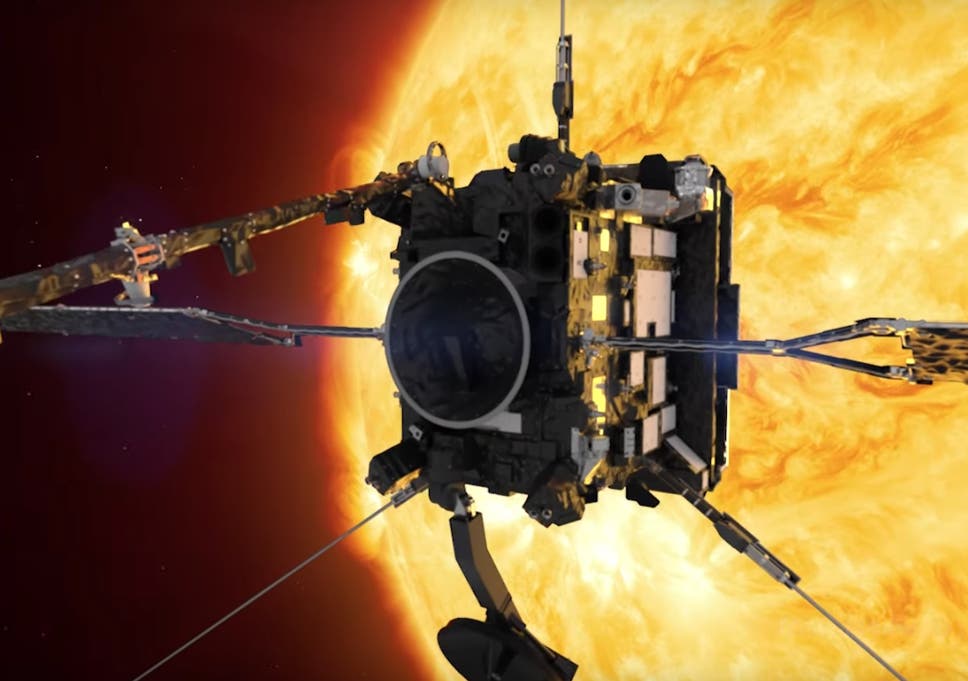
A British made spacecraft - partly made of baked animal bones - will launch from Cape Canaveral in Florida on Sunday evening, on a mission to take highly detailed photographs and measurements of the sun, including the first ever pictures of its mysterious poles.
The Solar Orbiter will undertake a mission expected to last at least 10 years, and will usher in a “golden age” of solar science, the team working on the project said.
“Nobody has been able to take images this close to the Sun before,” said Helen O’Brien at Imperial College London, who will manage the magnetometer instrument on the European Space Agency’s spacecraft, which also has Nasa involvement.
“We should see some beautiful images,” she told the journal Nature.
The €500m (£425m) spacecraft is equipped with ten instruments, to photograph the sun and examine its magnetic activity.
Using gravitational slingshot-style assists from Venus, the spacecraft will eventually be placed into a lopsided orbit that will bring it, at its closest, just 42 million kilometres from the sun.
The angle of the orbit will provide the first clear glimpses of the sun’s north and south poles – which are difficult to view from Earth as our planet orbits roughly in line with the celestial body’s equator.
Once in position, it will perform unprecedented close-up observations of the sun, providing the first images of the uncharted polar regions.
In order to keep the Solar Orbiter cool, it is equipped with a 150kg heat shield which will reflect and guide heat away from the spacecraft and can withstand up to 520C (970F).
“We’ve got a combination of telescopes which will look at the surface of the Sun and really see what’s going on, and then a suite of instruments which measure the solar wind which is what is thrown off the Sun all the time – the extended atmosphere, if you like, of the Sun,” Ms O’Brien told the BBC.
The heat shield is built like a 10-foot-by-8-foot sandwich, Nasa said. “The front layer – wafer-thin sheets of titanium foil – strongly reflects heat. A honeycomb-patterned aluminium base, covered in more foil insulation, forms the inner slice closest to the spacecraft.”
Overall, the shield is 15 inches thick. It also has several “eyes”: peepholes for five of the spacecraft’s remote-sensing instruments to peer through.
A black surface coats the titanium foil and is made from powdered baked animal bones.
This charcoal-like powder is “much like the pigments used in cave paintings thousands of years ago”, Nasa said.
“It’s funny that something as technologically advanced as this is actually very old,” Anne Pacros, the payload manager at the European Space Agency added.
The coating resists degradation under the blow of intense solar ultraviolet radiation. Although the black powder does absorb some heat, it’s excellent at shedding that heat back out to space.
One of the key objectives of the team is to work out what drives the solar wind – the constant stream of high energy particles and plasma leaving the Sun’s outer atmosphere.
Due to its proximity to the sun, the Solar Orbiter will be able to take measurements of the solar wind and energetic particles for the first time and before they have been impacted by their journey through space.
It is these charged particles reaching the Earth’s magnetic field at our planet’s north and south poles which cause auroras (the northern and southern lights).
“We will gradually fly out of the ecliptic plane, and that will give us the first-ever views of the solar poles,” said Daniel Müller, a solar physicist at ESA’s European Space Research and Technology Centre in Noordwijk, the Netherlands, who is the project scientist on the mission.
“We believe that is key to better understanding the Sun’s magnetic activity cycle, because over a timescale of 11 years, the magnetic polarity of the Sun changes, and the north pole becomes the south pole,” he told Nature.
The craft was assembled at Airbus in Stevenage, England, and has been described as the UK’s most important space mission for a generation.
The Solar Orbiter is due to be launched from Cape Canaveral in Florida at 23:03 local time (4:03 UK time) on Sunday 9 February.





